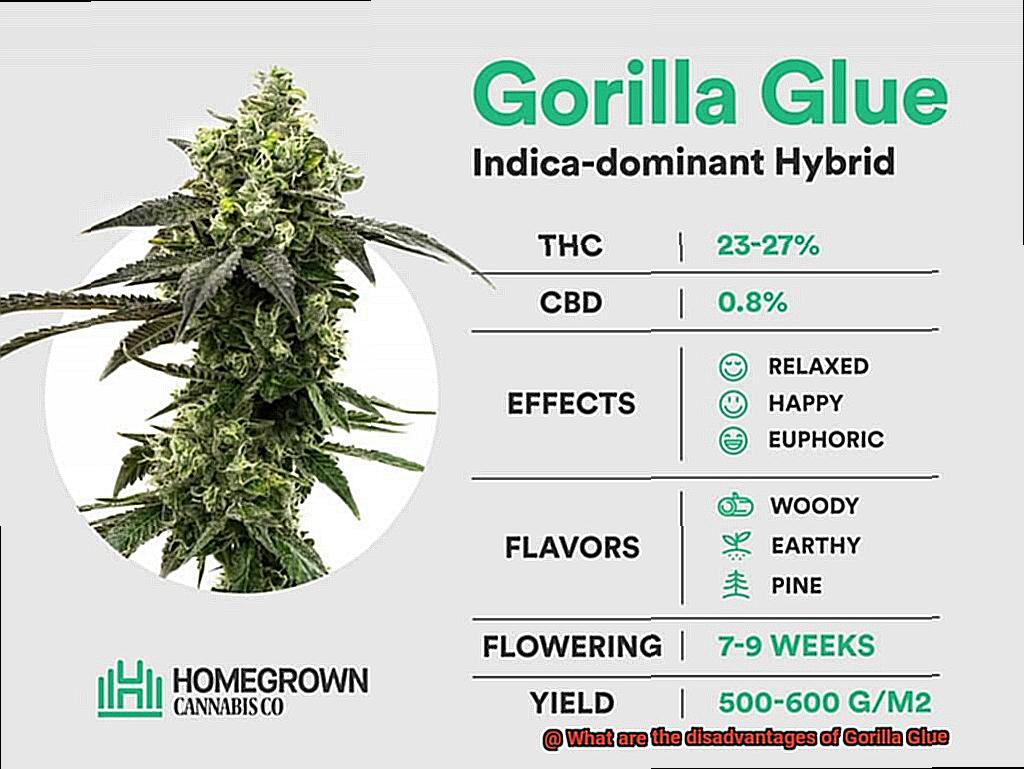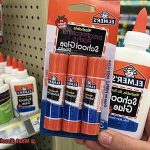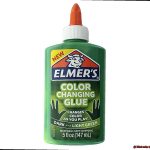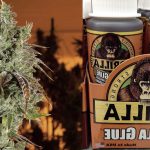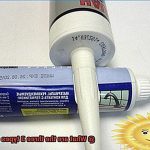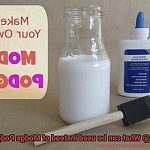Imagine this: You’re knee-deep in a DIY project, desperate for an adhesive that can hold your materials together like a champ. If you’ve ever ventured into the world of adhesives, chances are you’ve stumbled upon Gorilla Glue. Renowned for its Herculean bonding powers and ability to withstand even the harshest conditions, Gorilla Glue has become a go-to in countless toolboxes.
But here’s the thing: every product has its flaws, and Gorilla Glue is no exception. In this blog post, we’re going to dive headfirst into the potential downsides of using Gorilla Glue, pulling back the curtain on its less glamorous side.
Whether you’re a seasoned craftsman or just starting out on your DIY journey, understanding these limitations will give you the upper hand when it comes to choosing the perfect adhesive for your projects.
So grab your safety goggles and prepare for some sticky revelations, because we’re about to get real about Gorilla Glue’s disadvantages.
Expansion and Foaming
Contents
When it comes to adhesive strength, Gorilla Glue is highly regarded. However, like any product, it has its drawbacks. In this article, we will explore the potential disadvantages of Gorilla Glue’s expansion and foaming properties, which can affect its application, cause damage to surfaces, and present other challenges.
Messy Application:
One major drawback of Gorilla Glue’s expansion and foaming is the potential for a messy application. As the glue cures, it tends to expand beyond the intended area, resulting in excess foam that may overflow onto surrounding surfaces.
This can be particularly problematic for delicate or intricate projects where precision is crucial. Cleaning up the excess foam can be challenging and may leave behind a residue that is difficult to remove.
Bonding Issues:
Gorilla Glue’s expansion and foaming properties can also lead to bonding problems. As the glue expands, it exerts pressure on the materials being bonded, causing them to shift or move.
This can result in misalignment or uneven bonding, compromising the strength and durability of the bond. Promptly addressing these issues is essential to achieve a successful bond.
Aesthetic Implications:
In addition to messy application and bonding issues, Gorilla Glue’s expansion and foaming can have aesthetic implications. The excess foam that spills over during curing can create unsightly bumps or uneven surfaces.
This is particularly problematic when using Gorilla Glue on visible areas of a project, such as furniture or decorative items. Removing or smoothing out the foam requires additional time and effort.
Difficulties in Estimating Glue Quantity:
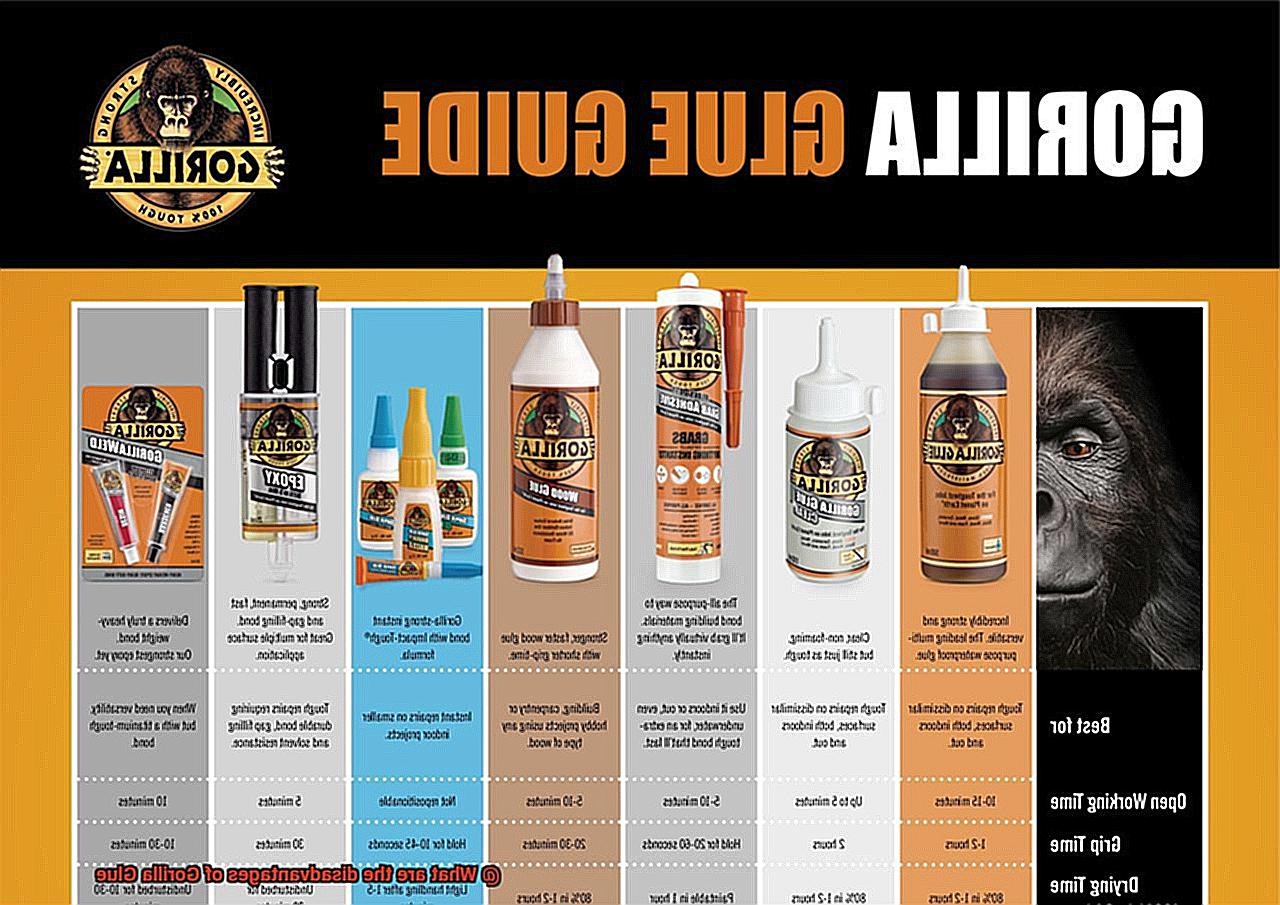
Controlling the amount of glue needed for a specific application can be challenging due to Gorilla Glue’s expanding nature.
Using too much glue can result in excessive foaming and overflow, while using too little may lead to weak bonding. Achieving the right balance and ensuring consistent results may require practice and experience.
Extended Drying Time:
Another drawback of Gorilla Glue’s expansion and foaming is its longer drying time. The foam created during the curing process takes longer to fully set and harden compared to other adhesives.
This extended drying time can be inconvenient, especially for time-sensitive projects or when immediate functionality is required.
Long Curing Time
When it comes to selecting the perfect adhesive, understanding its advantages and disadvantages is paramount. Today, we delve into the realm of Gorilla Glue, shedding light on one of its major downsides – its long curing time.
While this adhesive powerhouse boasts incredible bonding strength, it is essential to grasp how its leisurely drying process can impact your projects.
The Waiting Game:
Gorilla Glue’s curing time spans from 24 hours to several days, influenced by various factors. This extended drying period can prove inconvenient for those seeking prompt results or working under time constraints.
Accidental Movement:
During the curing process, glued materials may inadvertently shift or move. This unintended motion can weaken bonds or cause misalignment, compromising the glue’s effectiveness.
The Polyurethane Formula:
Gorilla Glue’s lengthy curing time can be attributed to its polyurethane-based formula. While this formula ensures durability and robust bonds, it necessitates more time to fully cure and harden compared to other adhesive options.
Moisture Matters:
The curing process of Gorilla Glue relies on moisture from the surrounding air or the materials being glued. High humidity levels or a dearth of moisture significantly prolong the drying time, putting your patience to the test.
Planning Ahead:
To mitigate the impact of long curing time, it is vital to allocate ample time for projects involving Gorilla Glue. This proactive approach might involve advanced scheduling or exploring alternative glues with faster drying times for time-sensitive endeavors.
Creating a Stable Environment:
Throughout the curing process, it is crucial to establish a stable and secure environment that prevents any disturbance or movement of the glued materials. Utilizing clamps or weights can help maintain alignment until the glue has reached full cure.
Not Suitable for All Materials
Today, we embark on a journey into the realm of adhesives to explore one of the industry heavyweights – Gorilla Glue. While this adhesive garners praise for its unparalleled strength and durability, it’s vital to remember that it’s not a universal solution.
In this post, we will delve into the reasons why Gorilla Glue may not be suitable for all materials and situations.
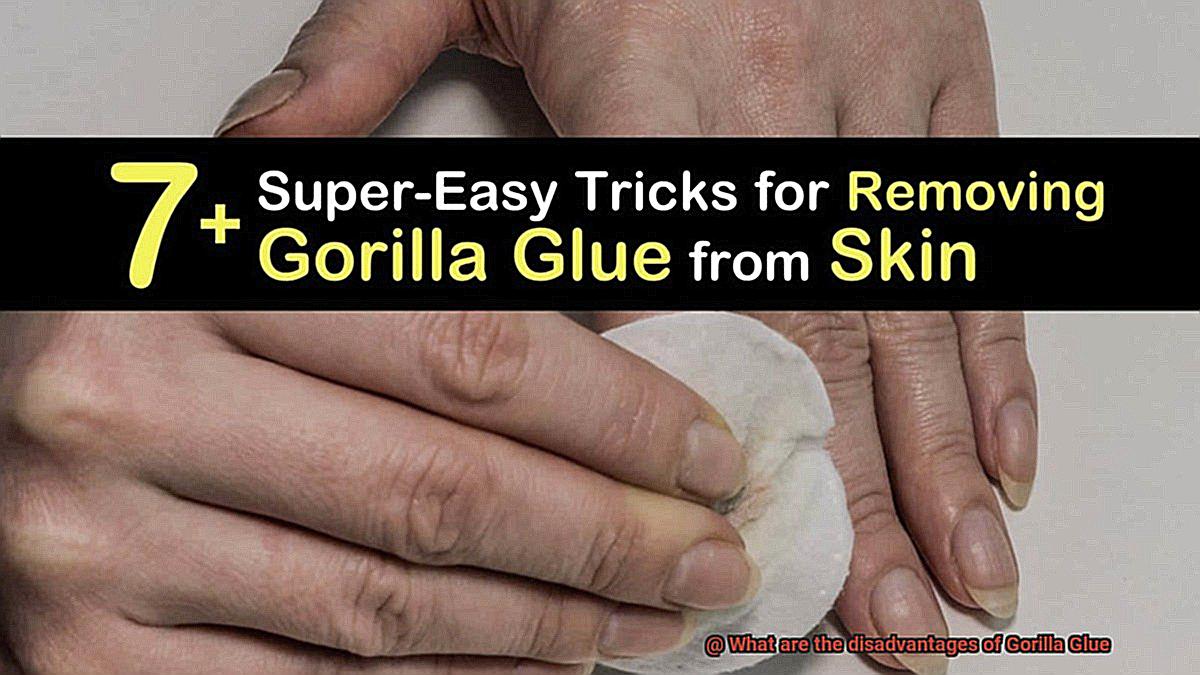
So, fasten your seatbelts and let’s begin this adhesive adventure.
Expansion Blues:
The remarkable strength of Gorilla Glue lies in its ability to expand as it dries. However, this very characteristic can prove to be a bane when working with delicate or porous surfaces such as fabric or Styrofoam.
The expanding nature of the glue can cause unwanted stiffness or distortion, undermining the integrity of your masterpiece.
Therefore, it’s crucial to seek alternative options when working with these materials.
Glass Conundrum:

Ah, the allure of glass – smooth and shiny. Unfortunately, Gorilla Glue struggles to adhere well to such sleek surfaces. If you envision bonding glass objects together with this adhesive superhero, it’s time to reconsider your strategy.
There are specialized glues designed exclusively for glass-to-glass bonding that will come to your rescue.
Plastic Puzzles:
Polyethylene and polypropylene plastics present a formidable challenge for Gorilla Glue due to their low surface energy. These plastics give our mighty adhesive a run for its money when it comes to forming a strong bond.
If you find yourself wrestling with these types of plastics, it’s high time to explore other adhesive options tailored specifically to their unique properties.
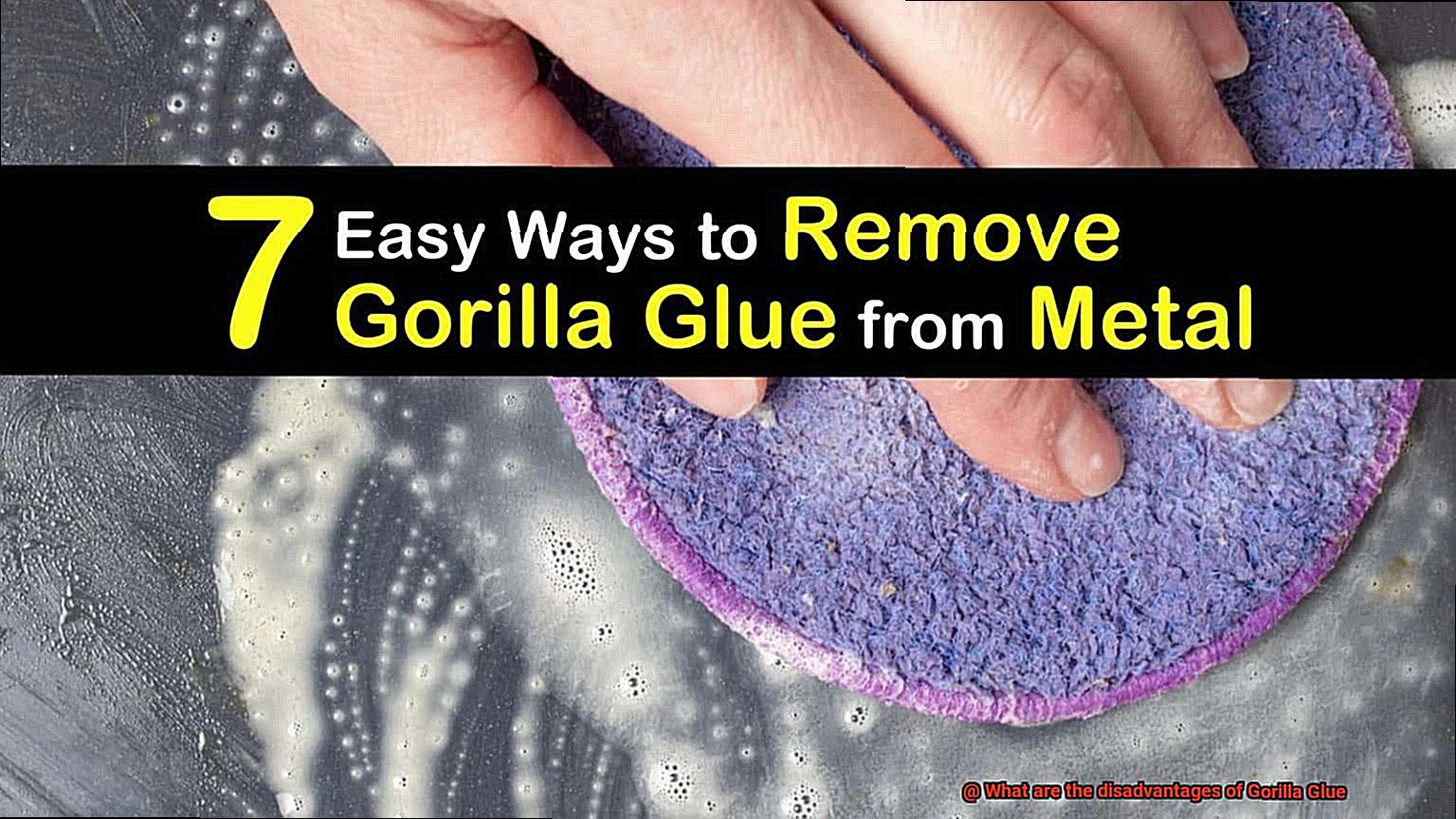
Moisture Matters:
Gorilla Glue thrives on moisture; it craves it for proper activation and curing. However, this reliance on moisture can be a double-edged sword. If you’re working in a dry environment or dealing with moisture-sensitive materials, it’s best to opt for a different adhesive. You don’t want your project to become a sticky mess or risk damaging the material you’re working with.
Strong Odor
The allure of the strong scent of glue is undeniable. It has a way of capturing our attention and evoking a sense of nostalgia. However, when it comes to Gorilla Glue, that strong odor may be a bit too much to handle.
This adhesive is not only renowned for its exceptional bonding power but also infamous for its overpowering smell.
The secret behind this pungent odor lies in the chemical composition of Gorilla Glue. It contains volatile organic compounds (VOCs), chemicals that easily evaporate into the air. And let me tell you, these VOCs are far from pleasant. In fact, their aroma can induce headaches and even make you feel queasy. Not exactly the kind of fragrance you want wafting through your workspace, is it?
But wait, there’s more. The stench of Gorilla Glue doesn’t just dissipate once it dries. No, it lingers in the air as if it has taken up permanent residence. And here’s the kicker – it can also transfer onto surfaces it comes into contact with. Imagine completing a project with this adhesive, only to have it leave behind an enduring stink. Talk about a buzzkill.
Now, don’t get me wrong – Gorilla Glue is still an exceptional adhesive that gets the job done. But if you plan on using it indoors or in tight spaces, precautions are necessary. Ensure that you’re working in a well-ventilated area or consider wearing a mask to minimize your exposure to the strong odor. And if you happen to have sensitivities or allergies to certain chemicals, exercise extra caution.
Not Waterproof
Before you grab that reliable Gorilla Glue, pause for a moment. While renowned for its exceptional strength, it’s crucial to grasp why this adhesive is not recommended for projects requiring water resistance. Let’s delve into the science behind Gorilla Glue’s lack of waterproof capabilities.
The Downside of Water Exposure:
Imagine this scenario: you painstakingly glue two items together using Gorilla Glue, only to discover later that the bond weakens when exposed to water or moisture. A frustrating setback. Unlike specialized waterproof glues, Gorilla Glue loses its adhesive properties in wet environments or upon contact with liquids.
Not for Submerging or Constant Water Exposure:
Need to repair swimming pool equipment or fix plumbing leaks? Regrettably, Gorilla Glue is not the right tool for the job. It simply cannot withstand constant exposure to water or being submerged underwater. Even items intended for outdoor use, exposed to rain and humidity, may suffer from weakened bonds if Gorilla Glue is used.
Breaking Down Underwater:
When Gorilla Glue encounters water after it cures, disaster strikes. It begins to break down and lose its bond. Say farewell to your meticulously crafted project as the glued items become loose or separate entirely. Talk about a glue fail.
Expansion and Uneven Surfaces:
Another drawback of Gorilla Glue is its tendency to expand during the curing process. This expansion can create gaps or uneven surfaces when bonding two items together. And guess what? If these gaps are exposed to water or moisture, it further compromises the integrity of the bond.
Finding Alternatives:
To avoid the pitfalls of non-waterproof adhesives like Gorilla Glue, consider specific options designed to withstand water exposure, such as waterproof epoxy adhesives or marine-grade adhesives. These alternatives offer the strength you need without sacrificing water resistance.
Pro Tips for Using Gorilla Glue:
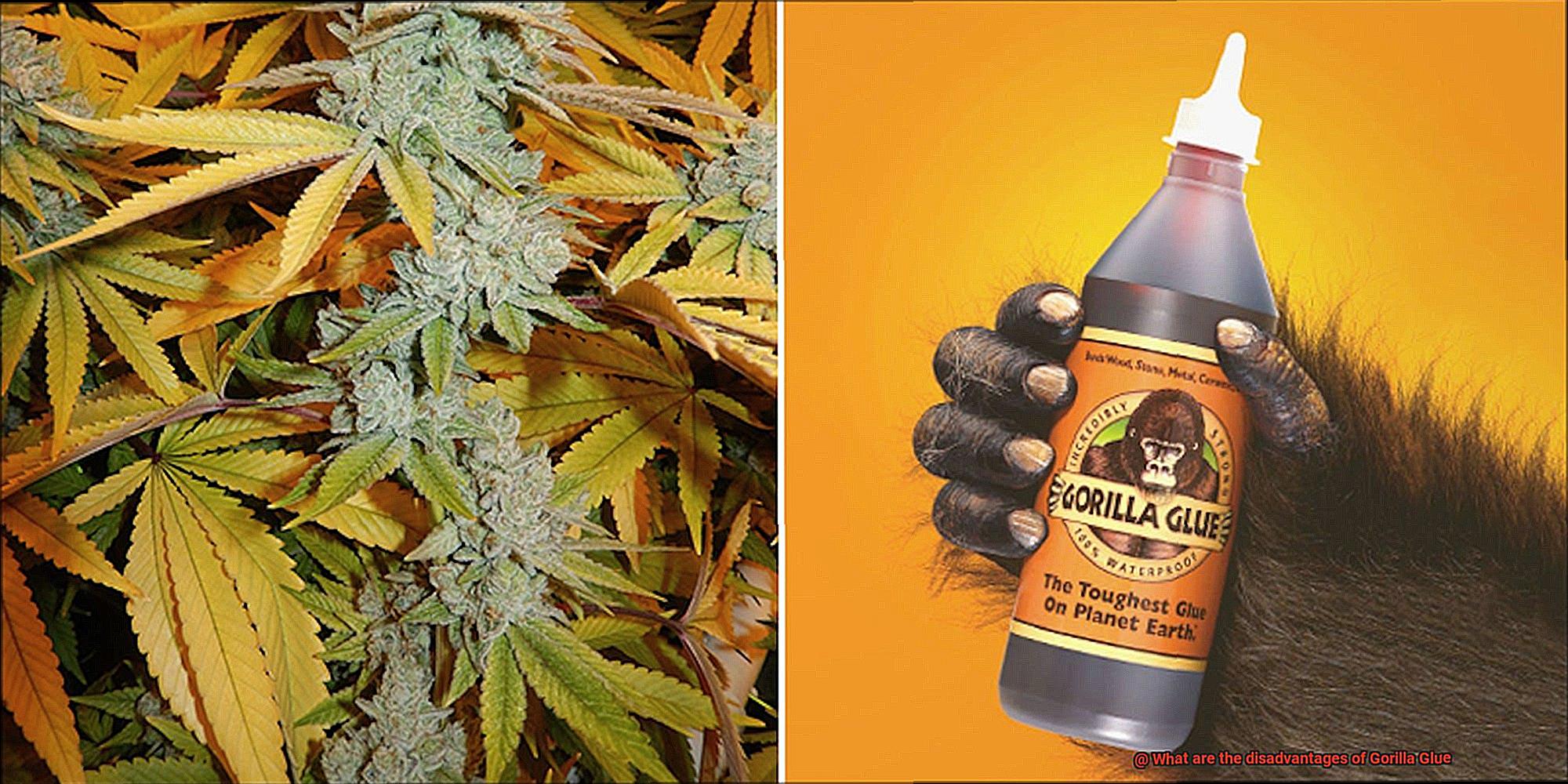
If you do choose to use Gorilla Glue, ensure that the surfaces are clean, dry, and free from any moisture. This will help maximize the bonding strength and longevity of the glue. And if water exposure is unavoidable, applying a waterproof sealant over the glued area can provide some protection.
Strength Can Be a Disadvantage
Renowned for its unparalleled strength and holding power, this adhesive seems unbeatable. But hold your glue guns, for we are about to reveal some surprising downsides to this mighty force.
First on our list of Gorilla Glue’s disadvantages is its stubbornness. Once this adhesive sets and cures, it forms an unyielding bond that is nearly impossible to break. While its durability is commendable, it becomes a real headache if you ever need to disassemble or modify something you’ve glued together. So, think twice before permanently joining those puzzle pieces.
Another drawback of Gorilla Glue’s strength is the risk of collateral damage. Delicate surfaces, such as glass or thin plastics, may suffer when attempting to separate them after they’ve been joined with this adhesive. The sheer force required can lead to unintended breakage or deformation, leaving you with a shattered dream and a messy cleanup.
Now, let’s talk safety. Proper ventilation is a must when working with Gorilla Glue. The fumes emitted during the curing process can be potent and irritating. Trust me, you don’t want to accidentally inhale those toxic fumes for too long. Additionally, be cautious of skin contact as this glue has a knack for sticking to everything – including your fingers.
Flexibility is another area where Gorilla Glue falls short. If your project requires a temporary bond or some flexibility, this adhesive may not be your best bet. Its permanent and rigid nature means it’s more suited for projects that demand sheer strength rather than versatility.
Finally, cleanup time. Unfortunately, Gorilla Glue’s unyielding grip extends beyond surfaces. Spills and excess glue can be a nightmare to clean up. Once it dries, this adhesive transforms into a stubborn residue that doesn’t budge easily. So, be careful where you’re applying that glue, or you might end up with an unsightly mess on your hands.
Remember, craft enthusiasts, while Gorilla Glue’s strength is undeniably impressive, it’s essential to consider these downsides before reaching for the gorilla in the glue aisle. Assess your project’s needs and carefully weigh the pros and cons.
Alternatives to Gorilla Glue
If you’re tired of finding yourself stuck in a sticky situation with Gorilla Glue, fear not. I am here to introduce you to a world of fantastic alternatives that will have you bonding like a pro, without the hassle. So let’s dive in and explore the vast array of glue options available.
- Epoxy Resin: This versatile adhesive offers similar bonding strength as Gorilla Glue, making it perfect for bonding different materials like wood, metal, and plastic. Not only is it waterproof, but it can also withstand extreme temperatures, making it suitable for both indoor and outdoor projects.
- Super Glue (Cyanoacrylate Glue): When working with delicate materials such as ceramics or glass, super glue is your go-to. It forms an instant bond and is ideal for small repairs. However, be aware that it may not be as effective for larger surfaces or porous materials.
- Wood Glue: Don’t overlook the trusty wood glue for woodworking projects. Specifically formulated for bonding wood pieces together, it provides a strong and clear bond. Keep in mind though, it may not be as versatile as Gorilla Glue when it comes to bonding different materials.
- Natural Adhesives: If you’re seeking non-toxic and eco-friendly options, consider using hide glue or animal-based glues. Made from natural ingredients, these glues can be easily dissolved with heat or water if repairs are needed.
- Fabric Glue and Adhesive Tapes: For fabric or textile bonding, fabric glue or adhesive tapes are your secret weapons. Designed to bond fabrics without damaging them, they can withstand washing and dry cleaning.
- Silicone Adhesive or Caulk: When it comes to sealing and bonding materials in plumbing, automotive, and construction projects, silicone adhesive or caulk is a reliable choice. Its flexibility and waterproof properties make it a go-to option.
- Double-Sided Adhesive Tapes: Let’s not forget the convenience of double-sided adhesive tapes. Perfect for temporary or lightweight bonding needs, these tapes are easy to apply and remove without leaving any residue.
When selecting an alternative to Gorilla Glue, factors such as bonding strength, flexibility, drying time, and compatibility with different materials should be considered. Read product labels and follow manufacturer instructions for the best results.
Safety Considerations When Using Gorilla Glue
Gorilla Glue is renowned for its extraordinary strength and versatility in bonding materials together. However, handling this powerful adhesive requires caution and an unwavering commitment to safety. Here are some vital safety considerations to bear in mind when using Gorilla Glue:
- Protective Gear: The first line of defense when working with Gorilla Glue is protective gear. Shield your hands by wearing gloves that prevent the adhesive from clinging to your skin, as it can cause irritation or allergic reactions. Equally important is the use of eye protection since Gorilla Glue can inflict severe damage if it comes into contact with your eyes.
- Ventilation: Picture this: fumes swirling ominously in the air as you work on your project. The fumes emitted by Gorilla Glue during the curing process can be harmful if inhaled in large quantities or in a poorly ventilated area. To avoid any respiratory mishaps, either use Gorilla Glue in a well-ventilated space or shield yourself with a mask to prevent the inhalation of these potentially dangerous fumes.
- Precision Application: Remember, less is more when it comes to Gorilla Glue. This adhesive has a propensity to expand as it cures, making it crucial to apply it sparingly. Applying excessive amounts of glue can lead to overflow, creating a messy situation that poses potential hazards.
- Proper Storage: Treat your Gorilla Glue with care by storing it in optimal conditions. Keep it in a cool and dry place, far away from heat sources and direct sunlight that could compromise its quality. Ensure the container is tightly sealed to prevent the glue from drying out or being contaminated.
- Keep Away from Children and Pets: While Gorilla Glue may seem like a fascinating substance to explore for children and pets, it is essential to keep it out of their reach. Accidental ingestion can have severe health consequences, as the adhesive is toxic if swallowed.
Remember, accidents happen. In case of accidental skin contact or ingestion, seek immediate medical attention. Provide the healthcare professional with the product’s label or container to ensure proper treatment.
Also Read: Does Gorilla Glue Work On Fabric?
Conclusion
In conclusion, it is important to consider the disadvantages of Gorilla Glue before using it for your projects. While it is a strong adhesive with many advantages, there are a few drawbacks to be aware of.
Firstly, Gorilla Glue can be messy to work with. Its thick consistency makes it difficult to apply precisely, and if you accidentally get it on your hands or surfaces that you don’t want glued together, it can be challenging to remove.
Secondly, Gorilla Glue requires moisture to activate its bonding properties. This means that you need to dampen one surface before applying the glue, which can be inconvenient in certain situations. Additionally, if the moisture level is not properly controlled, it can affect the strength and durability of the bond.
Furthermore, Gorilla Glue expands as it cures. While this expansion helps fill gaps and creates a strong bond, it can also lead to unintended consequences. If not used carefully or in small amounts, the expanding glue can seep out from between surfaces or cause them to warp.
Lastly, Gorilla Glue has a long curing time compared to other adhesives. It typically takes 24 hours for the glue to fully cure and reach its maximum strength. This extended drying time may not be suitable for projects that require immediate use or handling.
In summary, while Gorilla Glue offers many benefits in terms of strength and versatility, its disadvantages should be considered before use.

